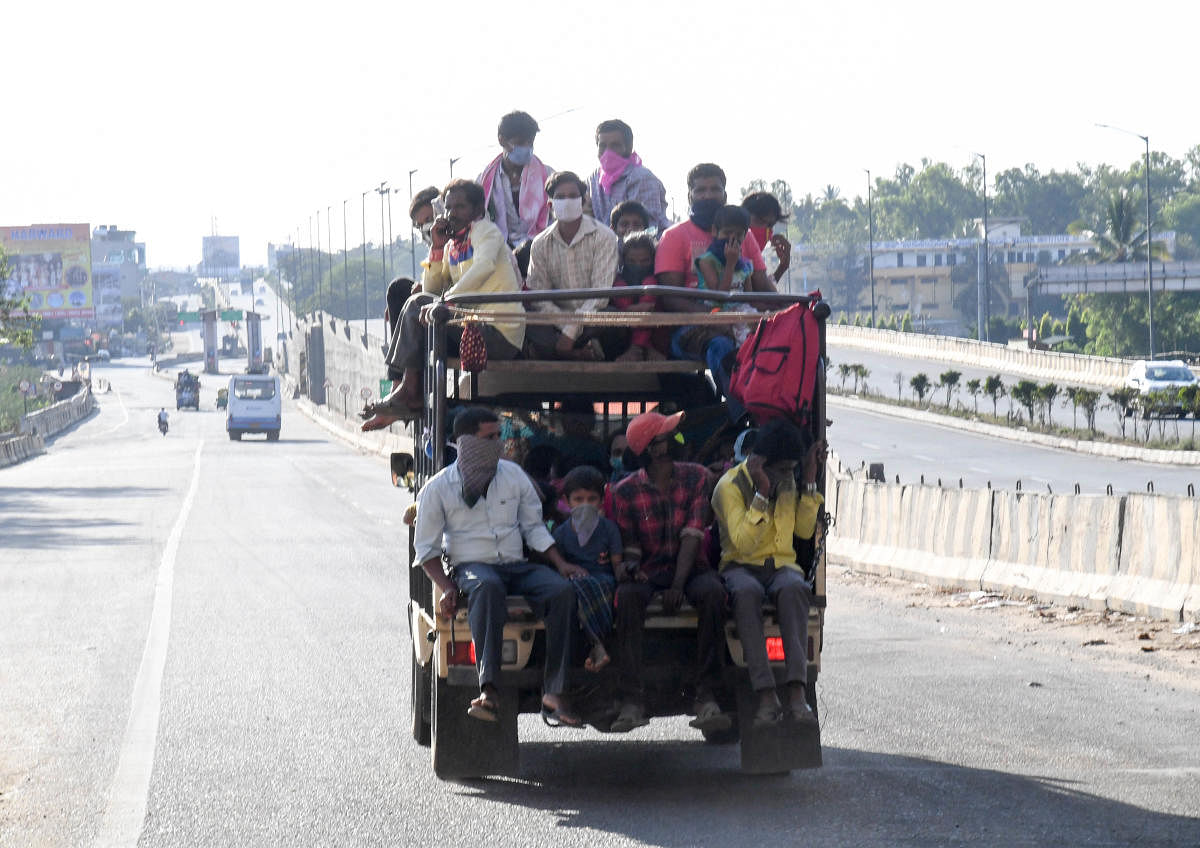
In Varanasi, the constituency of Prime Minister Narendra Modi, a village head (pradhan) faced a dilemma a few days ago. In front of him were three migrant labourers who returned to the hamlet after a strenuous journey and two groups of villagers who were divided on allowing these migrants into the hamlet.
The trio, who traversed hundreds of kilometres by foot and vehicles to reach their home, was not in good shape but showed no symptoms of COVID-19.
One section of villagers wanted them to be reported to the police immediately, while another vehemently opposed it. After much deliberation, the village head got them examined at a primary health centre, where they were declared safe to stay in their homes. But a neighbouring village objected to their presence soon after and the tension is continuing.
A 39-year-old who worked as a food delivery person in Delhi was not that fortunate. He set out on foot for his home in Madhya Pradesh’s Morena, around 325 km from Delhi.
He collapsed halfway through in Agra and breathed his last.
Activists put the figure of migrant labourer deaths at over 40 in the past fortnight, in the period India intensified its war against the novel coronavirus. None of them had contracted COVID-19. Those deaths spared, faced humiliation in several places, as one saw in Uttar Pradesh’s Bareilly, where officials made migrant labourers squat and sprayed disinfectants on them.
The turn of events after the COVID-19 lockdown was announced not only highlights the precarious situation of migrant labourers but also exposes the social faultlines in India’s hinterlands. Lakhs of workers have left cities after the Prime Minister announced a 21-day nationwide lockdown from March 25.
Several villages across the country turned hostile to their own people, as fear of the virus struck them hard. Social workers on the ground say the virus has not just evoked fear but also mistrust and anxiety, affecting the social fabric in these communities.
Tens of thousands could not leave and are still confined to their cramped accommodation in the cities. Those who are stranded are housed in relief camps – the Ministry of Home Affairs (MHA) puts this number at around 675,000 in over 21,486 shelters – set up in cities and along highways.
As governments at the Centre and states failed to anticipate the fallout and make a contingency plan, millions of migrant workers and their families in cities scrambled to get their life back on track.
The first signs of an impending exodus were noticed in Mumbai and other cities in Maharashtra, after the ‘Janata Curfew’ was announced. Videos on social media, showing migrants waiting at railway stations in Maharashtra for trains headed to Bihar, Uttar Pradesh and other north Indian states, indicated the things to come in the next few days.
After the lockdown was imposed, reports and visuals of thousands of migrant workers walking on foot poured in from Delhi and other north Indian cities and towns. Gripped with fear, anxious about their families back home, and with no word from the government about their welfare, for migrant workers, it appeared there was no way out but to walk home.
In the daily briefings in Delhi, Punya Salila Srivastava, Joint Secretary in MHA, has said the Centre, along with states, has taken several measures to help migrant workers by setting up
relief camps, ensuring food as well as instructing authorities to see to it that no one is evicted from their rented accommodations or not paid wages.
However, grassroots workers and experts have a different opinion. “We are worried about hunger and exhaustion among migrants who are stranded without food and work, far from their villages. Now we have recorded between 40-90 deaths that can be attributed to the lockdown,” development economist Reetika Khera, who teaches in IIM-Ahmedabad, told DH.
Lack of foresight
One of the defining visuals of the migrant exodus came from Anand Vihar bus terminal in Delhi, where thousands gathered on March 28, with hopes of travelling to Bihar and Uttar Pradesh. The event highlights the failure of the government in assuaging their concerns and enforcing the lockdown, which was meant to ensure social distancing to “break the chain” of virus spread.
Activists and politicians were warning the government about an impending crisis but no one was prepared. The authorities had nothing to offer to the migrant workers initially and in the run-up to the lockdown and later, it was trade unions like CPM-affiliated Centre for Indian Trade Union (CITU) and RSS-backed Bharatiya Mazdoor Sangh (BMS), which provided relief.
The first definitive intervention from the government came only after the exodus in Delhi unfolded. Then came the deluge of advisories, directions and actions – from setting up relief camps and providing food to taking disciplinary action against four senior Delhi government officials, for failing to enforce lockdown among others. By then, young and old, pregnant and
children were on the streets.
“We faced serious floods in Kerala last year. We were not scared then. Now we are really scared of COVID-19. We want to go back home but there are no trains,” said Sahadeb Roy, a driver from Assam’s Kokrajhar, working in Kerala for the past 10 years and presently stuck in Kannur.
‘Find me a shelter’
Ramkumar, who hails from Bihar and pulls a rickshaw in east Delhi’s Laxmi Nagar, sums it up: “I desperately want to go home. It is not easy here. There are food distribution centres but initially, I did not get anything to eat for two days. I don’t know how I will survive. I sleep in my rickshaw and I don’t know where the relief shelter is. Nobody tells me.”
The situation of those in relief camps is not rosy either. Several complain about the facilities, though they acknowledge that in times of crisis, one cannot make much fuss about many things.
Millions of migrant workers are stranded in Kerala, Karnataka, Andhra Pradesh, Telangana and Maharashtra and complain about food scarcity, despite several states taking initiatives. Protests had also erupted in Kerala and Gujarat, where workers wanted to be allowed to go home.
How long will the lockdown continue? What is in store when they return to the cities for work once the lockdown is over? These questions continue to bother them and they fear for the future. Many of them are not optimistic.
“This fear and anxiety will have a lasting impact. People from Bihar, UP, Rajasthan etc will have to return to cities for livelihood. They cannot stay back in the village and depend on agriculture. They will face trouble in cities too as the construction sector and small-scale units may not be in good shape,” Prof Manish K Jha of Tata Institute of Social Sciences told DH.
Khera adds: “If the government wanted to lockdown, it should have started by announcing relief measures before declaring the lockdown. Relief measures should have included opening up all schools, community halls, stadiums as temporary shelters and opening community kitchens in each block of the country. It’s not too late yet.”
Activists and academicians point to further deterioration in societal relationships, as they warn about food scarcity, if not food riots. The lockdown also came during the cropping season and many are stranded in cities. They point out to possible drop in production, which can further lead to social tension.
CITU National Secretary Elamaram Kareem acknowledges that workers are anxious about their future and government has to intervene proactively.“The actions of the government have so far not been inspiring, especially when it comes to workers and the poor,” he told DH.
Workers stranded in cities, those in their homes in villages and those biding their time in relief shelters, now stare at an uncertain future. For them, life will get tougher than what it was with shrinking jobs, rising prices and widening social gap.
(With inputs from Sumir Karmakar, Mrityunjay Bose, Arjun Raghunath and Soumya Das)

